Identification of Milankovitch Cycles and Their Sedimentary Responses in Fine-Grained Depositional Strata on the Southwestern Margin of the Songliao Basin
Abstract
:1. Introduction
2. Regional Geological Setting
3. Theory and Methods
3.1. Data and Sample Selection
3.2. Signal Analysis
3.3. Calculation of Theoretical Orbital Period
3.4. TOC and Element Geochemical Analysis
4. Results
4.1. Cyclic Response Characteristics of Paleoclimatic Environments
4.2. Milankovitch Cycle Analysis
4.3. Identification and Division of High-Frequency Sedimentary Cycles
4.4. The Response of Paleoclimatic Environments to Astronomical Cycles
5. Discussion
Organic Matter Preservation Patterns Controlled by Astronomical Cycles
6. Conclusions
Author Contributions
Funding
Institutional Review Board Statement
Informed Consent Statement
Data Availability Statement
Conflicts of Interest
References
- Berger, A. Milankovitch theory and climate. Rev. Geophys. 1988, 26, 624–657. [Google Scholar] [CrossRef]
- Dong, X.J.; Feng, Z.D.; Ning, S.Y.; Zhang, P.F.; Chen, T.; Zhang, L.; Gao, D.; Wu, W. Milankovitch eycle and sedimentary response of Es42, fine-grained sedimentary rocks in Dongying depression. J. Henan Polytech. Univ. (Nat. Sci.) 2022, 41, 46–56. [Google Scholar]
- Peng, J.; Yu, L.D.; Xu, T.Y.; Han, H.D.; Yang, Y.M.; Zeng, Y.; Wang, Y.B. Logging identification of Milankovitch cycle and environmental response characteristics of lacustrine shale—A case study on Es 4scs in Well Fanye 1, Dongying Sag, Jiyang Depression, Bohai Bay Basin. Oil Gas Geol. 2022, 43, 957–969. [Google Scholar]
- Lin, S.S.; Shan, J.F.; Yan, J.C.; Li, X.Y.; Liu, G.W. Eocene Milankovitch Record and Its Indicative Significance of Depositional Response in the Northern Nanpu. Sag Sci. Technol. Eng. 2023, 23, 8085–8094. [Google Scholar]
- Shi, J.Y.; Jin, Z.J.; Liu, Q.Y.; Huang, Z.K. Recognition and Division of High-resolution Sequences based on the Milankovitch Theory: A case study from the Middle Jurassic of Well Ary301 in the South Turgay Basin. Acta Sedimentol. Sin. 2017, 35, 436–448. [Google Scholar]
- Yang, X.; Liu, B.; Zhang, J.C.; Huo, Z.P. Identification of Sedimentary Responses to the Milankovitch Cycles inthe K2qn1 Formation, Gulong Depression. Acta Sedimentol. Sin. 2019, 37, 661–673. [Google Scholar]
- Park, J.; Oglesby, R.J. Milankovitch rhythms in the Cretaceous: A GCM modelling study. Glob. Planet. Change 1991, 4, 329–355. [Google Scholar] [CrossRef]
- Liu, H.Y.; Pei, J.X.; Yang, X.; He, S.Y.; Liu, X.L.; Cui, Y.J.; Hao, L. Geochemical Characteristics and research Significance of Source rocks of Yixian Formation, Northern Naiman. Spec. Oil Gas Reserv. 2022, 29, 31–37. [Google Scholar]
- Zhao, X.Q.; Chen, J.F.; Zhang, C.; Li, Q.C.; Tang, Y.J.; Zhang, J.H. Gerochenmical Characteristics of Hydrocarbon Gases and Its Genetic Analysis in Nai 1 Block, Naiman Oilfield. Nat. Gas Geosci. 2011, 22, 715–722. [Google Scholar]
- Fan, H.R. Reservoir Characteristics and Evaluation of Block Nai 1 in the Naiman Area. Mud Logging Eng. 2007, 29–33+76. [Google Scholar]
- Liu, X.L. Analysis of the Paleo-environmental Evolution of the Lower Cretaceous in the Naiman Depression. Neijiang Sci. Technol. 2023, 44, 84–85. [Google Scholar]
- Huang, Y.H. Research on Sequence Stratigraphy and Sedimentary Facies of Jiu Fotang Formation in Nai Manqi Depression. Ph.D. Thesis, China University of Geosciences, Beijing, China, 2008. [Google Scholar]
- Liu, J.Y. Reservoir Characteristics and Evaluation of the Upper Section of the Jiufotang Formation in the Naiman Depression. Master’s Thesis, Northeast Petroleum University, Daqing, China, 2010. [Google Scholar]
- Zhao, X.Q.; Chen, J.F.; Cheng, R.; Liu, W.S.; Li, X.D.; Yi, C.; Zhang, Z.L.; Zhu, P.F.; Guo, W. Geochemical characteristics of formation water and hydrocarbon preservation of Jiufotang Formation in Nai 1 block of Naiman sag, Kailu Basin. J. China Univ. Pet. 2015, 39, 47–56. [Google Scholar]
- Li, M.S.; Ogg, J.; Zhang, Y.; Huang, C.J.; Hinnov, L.; Chen, Z.Q.; Zou, Z.Y. Astronomical tuning of the end-Permian extinction and the Early Triassic Epoch of South China and Germany. Earth Planet. Sci. Lett. 2016, 441, 10–25. [Google Scholar] [CrossRef]
- Song, C.Y.; Lv, D.W. Advances in Time Series Analysis Methods for Milankovitch Cycles. Acta Sedimentol. Sin. 2022, 40, 380–395. [Google Scholar]
- Sun, S.Y.; Liu, H.M.; Cao, Y.C.; Zhang, S.; Wang, Y.; Yang, W.Q. The Milankovitch cycle of lacustrine deepwater fine-grained sedimentary rocks and its significance for shale oil: A case study of the upper Es4 member of Well NY1 in the Dongying sag. J. China Univ. Min. Technol. 2017, 46, 846–858. [Google Scholar]
- Song, M.S.; Liu, H.M.; Wang, Y.; Liu, Y.L. Enrichment rules and exploration practices of Paleogene shale oil in Jiyang Depression, Bohai Bay Basin, China. Pet. Explor. Dev. 2020, 47, 225–235. [Google Scholar] [CrossRef]
- Chen, Q.H.; Zhang, F.Q.; Sun, S.P.; Liu, C.Y. Application of pattern recognition in stratigraphic division. Oil Gas Geol. 2004, 25, 102–105+114. [Google Scholar]
- Ren, J.F.; Liao, Y.T.; Sun, M.; Zhao, S.E.; Liu, X.L.; Song, G.Z. A method for quantitative division of high-resolution sequence stratigraphy based on wavelet transform and its application. Prog. Geophys. 2013, 28, 2651–2658. (In Chinese) [Google Scholar]
- Wu, H.C.; Zhang, S.H.; Huang, Q.H. Establishment of floating astronomical time scale for the terrestrial Late Cretaceous Qingshankou Formation in the Songliao basin of Northeast China. Earth Sci. Front. 2008, 15, 159–169. [Google Scholar] [CrossRef]
- Chen, Y.; Tang, W.Q.; Zhang, C.Z.; Wu, X.H.; Yang, Y.; Xing, H.T. Study on Paleoclimate and Dentification of High Frequency Cycle Based on Natural Gamma Ray Logging Data. Well Logging Technol. 2021, 45, 416–423. [Google Scholar]
- Zhang, R.L.; Jin, S.D. Cyclostratigraphy research on lower Member 3 of Shahejie Formation in Well Luo 69 in Zhanhua Sag Bohai Bay Basin. J. Cent. South Univ. (Sci. Technol.) 2021, 52, 1516–1531. [Google Scholar]
- Zhang, T.; Zhang, C.M.; Huo, J.H.; Zhu, R.; Yuan, R. Identification and comparison of high frequency cycles based on Milankovitch theory: A case study of Baikouquan formation in Mahu depression, Junggar basin. J. Northeast. Pet. Univ. 2017, 41, 54–61+7. [Google Scholar]
- Yu, L.D.; Peng, J.; Xu, T.Y.; Han, H.D.; Yang, Y.M. Analysis of Organic Matter Enrichment and Influences in Fine-grained Sedimentary Strata in Saline Lacustrine Basins of Continental Fault Depressions: Case study of the upper sub-section of the upper 4thmember of the Shahejie Formation in the Dongying Sag. Acta Sedimentol. Sin. 2024, 42, 701–722. [Google Scholar]
- Wu, H.; Zhao, D.N.; Jiang, T.T.; Gong, X.K.; Chen, J.M.; Chen, C.B. Stratigraphic Division and Correlation Method Based on Milankovitch High-Frequency Cycle—Taking the Key Ordovician Strata on the Western Margin of the Ordos Basin as an Example. Pet. Geol. Eng. 2023, 37, 1–8+16. [Google Scholar]
- Jia, D.L.; Tian, J.C.; Lin, X.B.; Yang, G.H.; Feng, W.X.; Zhang, X.; Tang, Y.; Yang, C.Y. The Milankovitch cycle sedimentary record of the Silurian Kalpintag Formation in the Shuntuoguole area of the Tarim Basin. Oil Gas Geol. 2018, 39, 749–758. [Google Scholar]
- Liang, C. Sedimentary The Sedimentation and Reservoir Formation Mechanism of Hydrocarbon-Bearing Fine-Grained Sedimentary Rocks. Ph.D. Thesis, China University of Geosciences, Beijing, China, 2015. [Google Scholar]
- Hinnov, L.A. Cyclostratigraphy and its revolutionizing applications in the earth and planetary sciences. GSA Bull. 2013, 125, 1703–1734. [Google Scholar] [CrossRef]
- Berger, A.; Loutre, M.F.; Laskar, J. Stability of the astronomical frequencies over the earth’s history for paleoclimate studies. Science 1992, 255, 560–565. [Google Scholar] [CrossRef]
- Laskar, J.; Robutel, P.; Joutel, F.; Gastineau, M.; Correia, A.C.M.; Levrard, B. A long-term numerical solution for the insolation quantities of the earth. Astron. Astrophys. 2004, 428, 261–285. [Google Scholar] [CrossRef]
- Shi, J.Y.; Jin, Z.J.; Liu, Q.Y.; Huang, Z.K.; Zhang, R. Quantitative classification of high-frequency sequences in fine-grained lacustrine sedimentary rocks based on Milankovitch theory. Oil Gas Geol. 2019, 40, 1205–1214. [Google Scholar]
- Jones, B.; Manning, D.A.C. Comparison of geochemical indices used for the interpretation of palaeoredox conditions in ancient mudstones. Chem. Geol. 1994, 111, 111–129. [Google Scholar] [CrossRef]
- Tribovillard, N.; Algeo, T.J.; Lyons, T.; Riboulleau, A. Trace metals as paleo-redox and paleoproductivity proxies: An update. Chem. Geol. 2006, 232, 12–32. [Google Scholar] [CrossRef]
- Liu, Q. Element geochemical characteristics of source rocks in the Shahejie Formation in Well Fangye-1, Dongying Sag and their geological significance. Pet. Geol. Recovery Effic. 2017, 24, 40–45+52. [Google Scholar]
- Ding, J.H.; Zhang, J.C.; Shi, G.; Shen, B.J.; Tang, X.; Yang, Z.H.; Li, X.Q.; Li, C.X. Sedimentary environment and organic matter enrichment mechanisms of the Upper Permian Dalong formation shale, Southem Anhui Province, China. Oil Gas Geol. 2021, 42, 158–172. [Google Scholar]
- Mao, K.N.; Xie, X.N.; Xu, W.; Kang, B. Identification and division of high-frequency cycles based on Milakovitch theory: A case study on Miocene Sanya and Meishan Formations in Qiongdongnan Basin. Pet. Geol. Exp. 2012, 34, 641–647. [Google Scholar]
- Sun, L.X.; Zhang, Y.; Zhang, T.F.; Cheng, Y.H.; Li, Y.F.; Ma, H.L.; Yang, C.; Guo, J.C.; Lu, C.; Zhou, X.G. Jurassic sporopollen of the Yan’an Formation and Zhiluo Formation in the northeastern Ordos Basin, Inner Mongolia, and its paleoclimatic significance. Earth Sci. Front. 2017, 24, 32–51. [Google Scholar]
- Shi, J.Y. Recognition of Milankovitch Cycles in the Eoceneterrestrial Formation and Environmental Responses in Dongying Sag. Ph.D. Thesis, China University of Geosciences, Beijing, China, 2018. [Google Scholar]
- Zhang, B.; Yao, Y.M. Race Element and Palaeoenvironmental Analyses of the Cenozoic Lacustrine Deposits in the Upper Es4 Submember of the Dongying Basin. J. Stratigr. 2013, 37, 186–192. [Google Scholar]
- Wang, F.; Liu, X.C.; Deng, X.Q.; Li, Y.H.; Tian, J.C.; Li, S.X.; You, J.Q. Geochemical Characteristics and Environmental Implications of Trace Elements of Zhifang Formation in Ordos Basin. Acta Sedimentol. Sin. 2017, 35, 1265–1273. [Google Scholar]
- Wu, H.C.; Zhang, S.H.; Feng, Q.L.; Fang, N.Q.; Yang, T.S.; Li, H.Y. Theoretical Basis Research Advancement and Prospects of Cyclostratigraphy. Earth Sci.—J. China Univ. Geosci. 2011, 36, 409–428. [Google Scholar]
- Zhao, J.; Zhao, K.; Zhang, J.Y. Division and Comparison of Oil Reservoirs in Delta Front from Milankovitch Astronomical Cycles. Acta Sedimentol. Sin. 2022, 40, 801–812. [Google Scholar]
- Li, S.J.; He, S.; Zhu, W.L.; Wang, X.L.; Wu, J.F.; Cheng, T. The Study on the sedimentation rate of source rocks based on cyclostratigraphic analysis in the Zhuyu Depression. Nat. Gas Geosci. 2014, 25, 1328–1340. [Google Scholar]
- Mei, M.X.; Gao, J.H. The Principle and Method of Lithostratigraphy Phase; Geological Publishing House: Beijing, China, 2005; pp. 141–151. [Google Scholar]
- Wang, H.Z.; Shi, X.Y.; Wang, X.L. Research on the Sequence Stratigraphy of China; Guangdong Science and Technology Press: Guangzhou, China, 2000; pp. 20–25. [Google Scholar]
- Zheng, R.C.; Peng, J.; Wu, C.R. Grade Division of Base-Level Cycles of Terrigenous Basinand Its Implications. Acta Sedimentol. Sin. 2001, 19, 249–255. [Google Scholar]
- Yang, S.H. Cretaceous Strata SIMS Zircon U-Pb Dating in Northern Hebei Province and Songliao Basin. Ph.D. Thesis, China University of Geosciences, Wuhan, China, 2010. [Google Scholar]
- Chen, J.S.; Li, B.; Yao, Y.L.; Liu, M.; Yang, F.; Xing, D.H.; Li, W.; Wang, Y. Comparison Between Mesozoic Volcanic Rock Strata in Northeast of Liaoning: South of Jilin and Yixian Formationg in West of Liaoning. Acta Geol. Sin. 2016, 90, 2733–2746. [Google Scholar]
- Deng, H.W.; Qian, K. Sedimentary Geochemistry and Environmental Analysis; Gansu Science and Technology Press: Lanzhou, China, 1993; pp. 1–150. [Google Scholar]
- Yu, L.D.; Peng, J.; Xu, T.Y.; Wang, Y.B.; Han, H.D. A study on astronomical cycle identification and environmental response characteristics of lacustrine deep-water fine-grained sedimentary rocks: A case study of the Lower submember of member 3 of Shahejie Formation in well fanye-1 of Dongying Sag, Bohai Bay Basin, China. Geofluids 2021, 2021, 5595829. [Google Scholar]


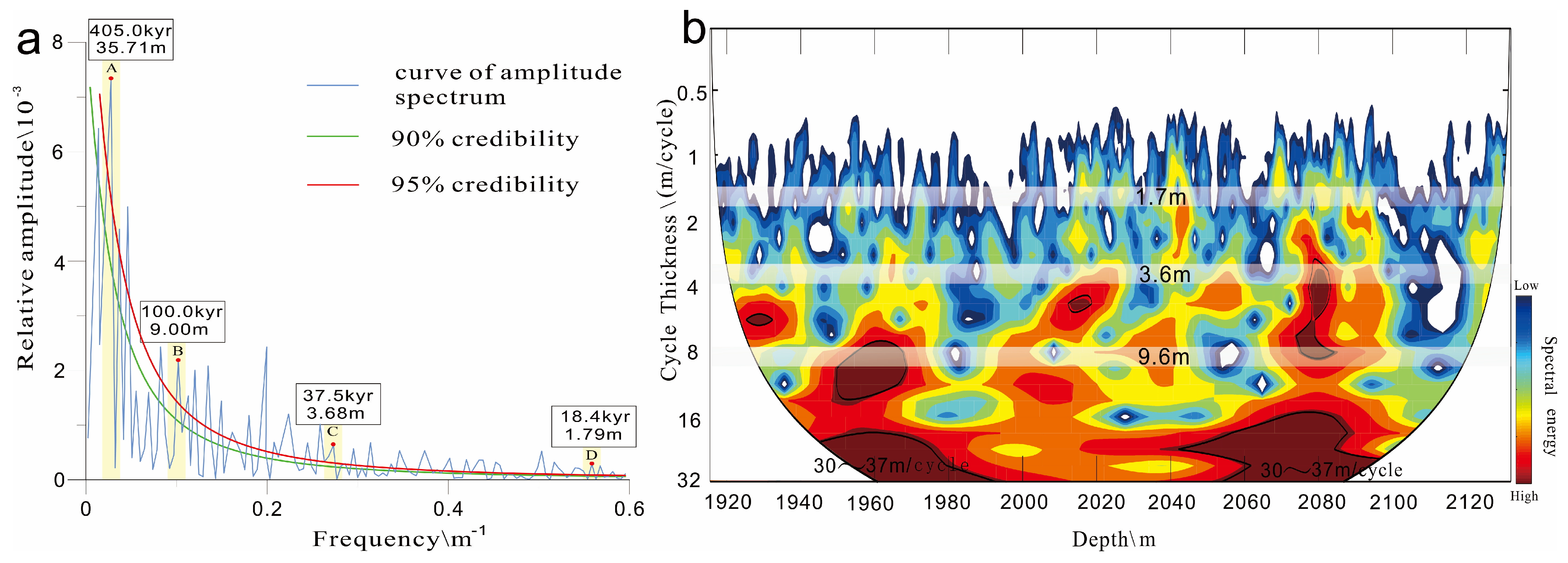
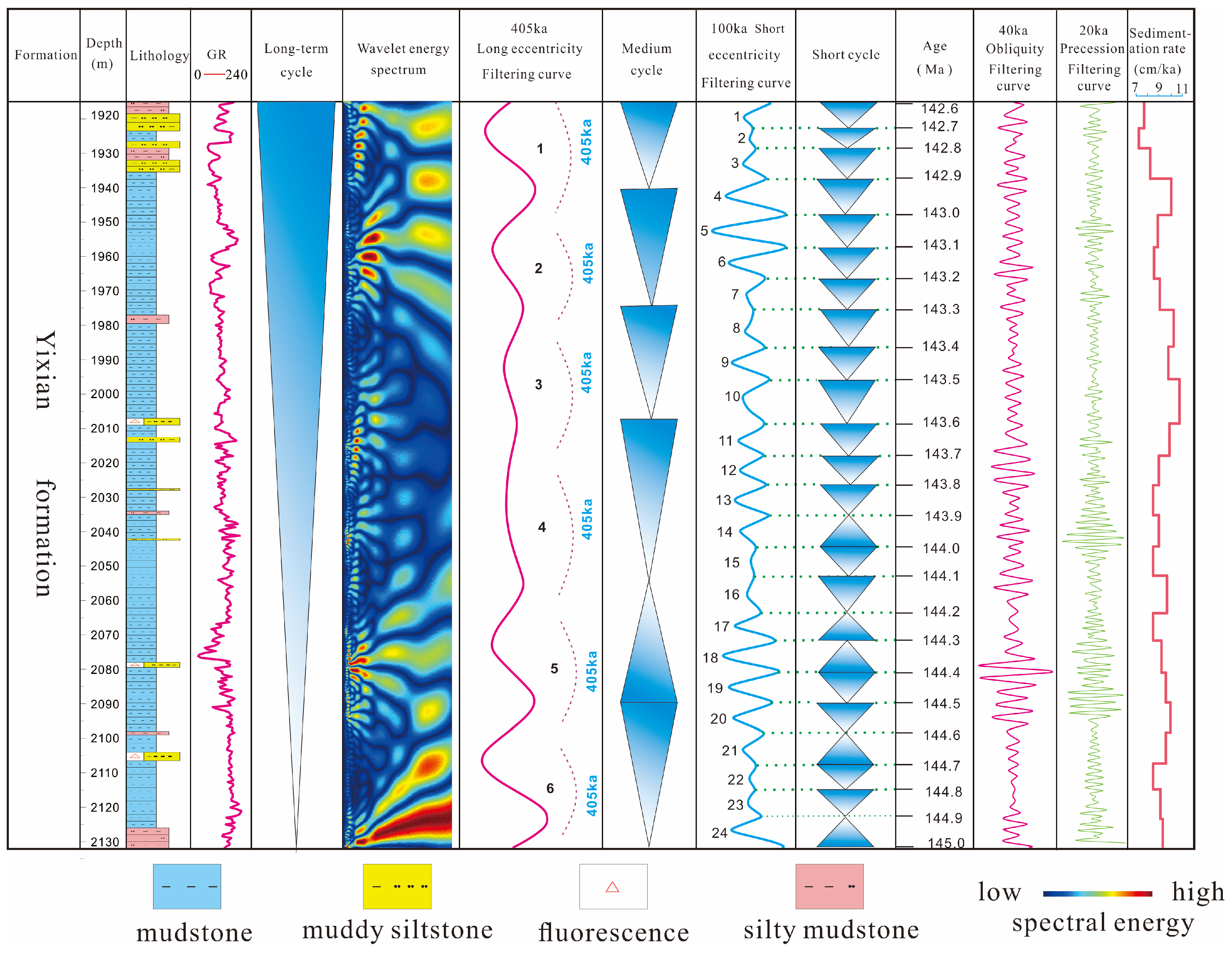
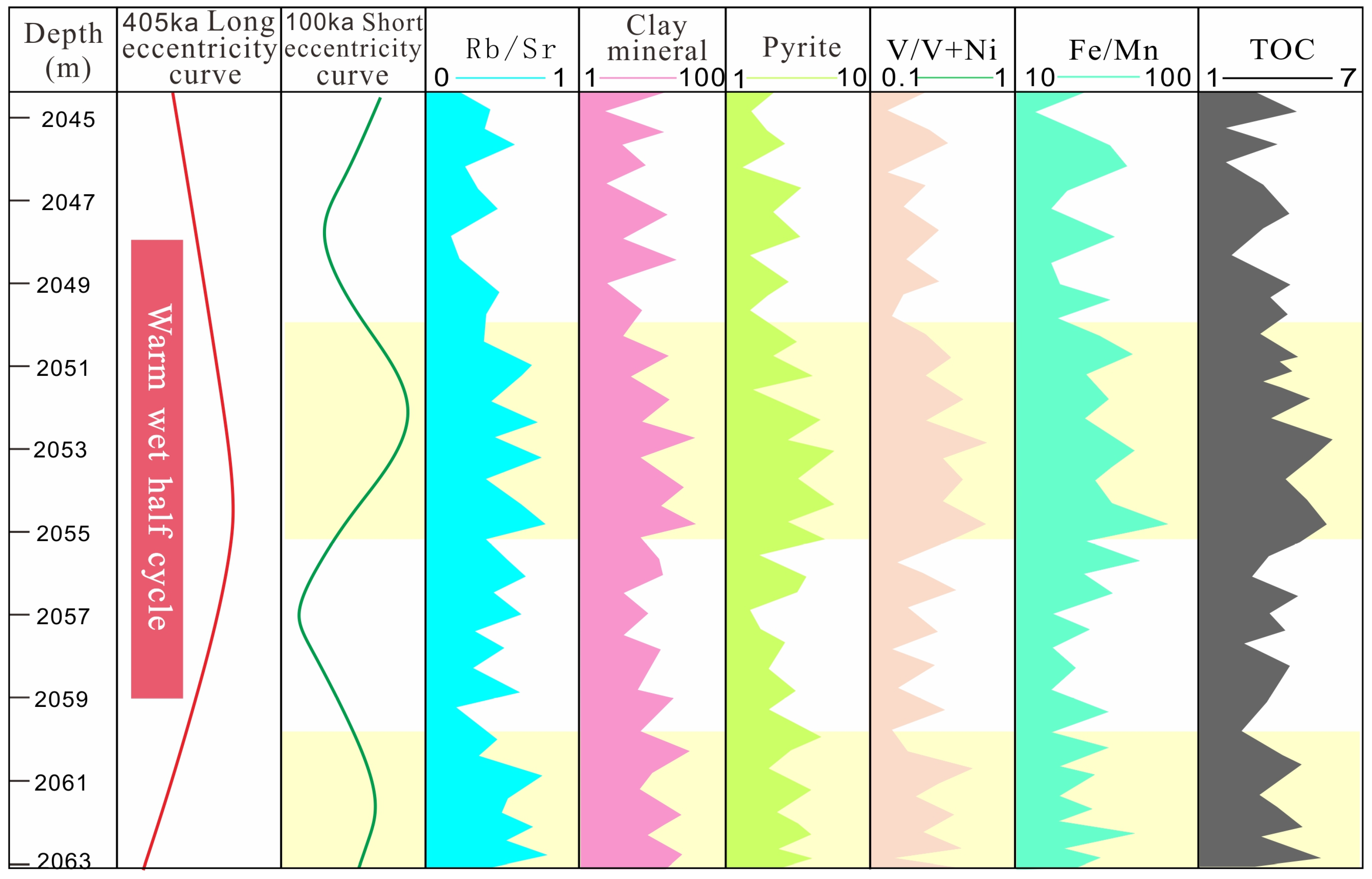
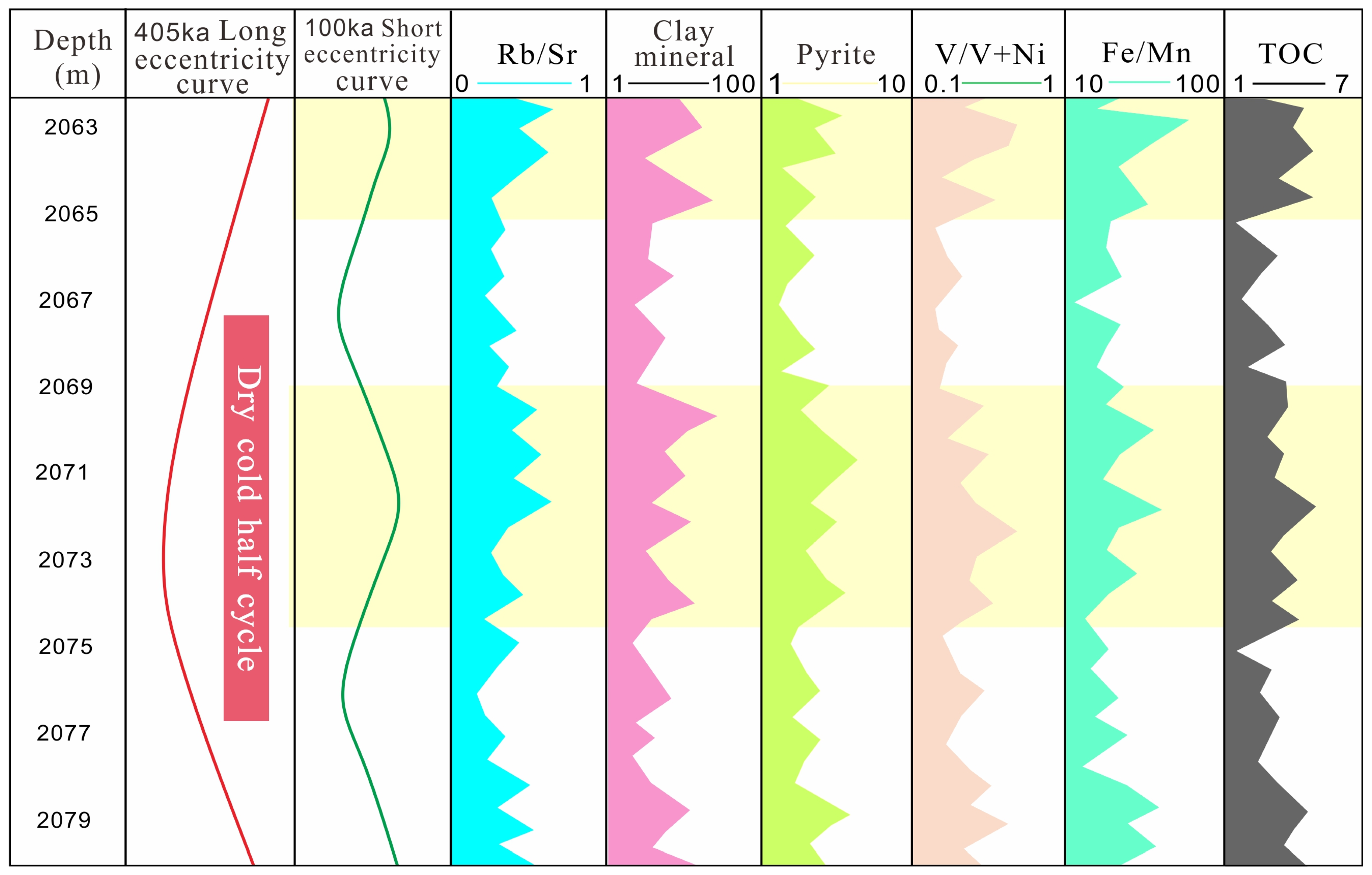


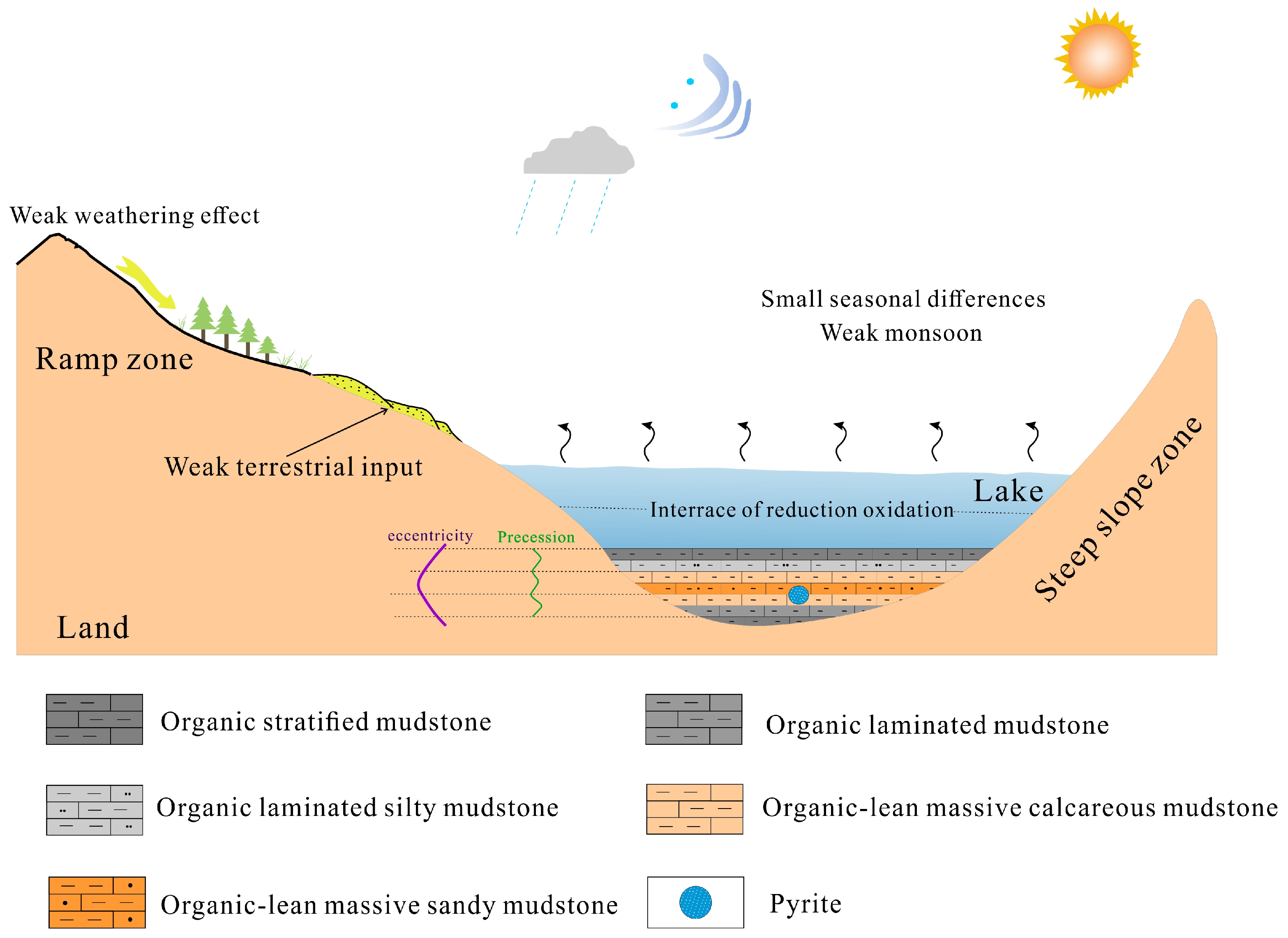
| Name | Theoretical Cycle/kyr | Cycle | Ratio | ||||||
|---|---|---|---|---|---|---|---|---|---|
| Eccentricity | 405 | 1.00 | — | — | — | — | — | — | — |
| 125 | 3.24 | 1.00 | — | — | — | — | — | — | |
| 100 | 4.05 | 1.25 | 1.00 | — | — | — | — | — | |
| Obliquity | 48.0 | 8.44 | 2.60 | 2.08 | 1.00 | — | — | — | — |
| 40.0 | 10.13 | 3.13 | 2.5 | 1.20 | 1.00 | — | — | — | |
| 37.5 | 10.8 | 3.33 | 2.67 | 1.28 | 1.07 | 1.00 | — | — | |
| Precession | 22.5 | 18.00 | 5.56 | 4.44 | 2.13 | 1.78 | 1.67 | 1.00 | — |
| 18.4 | 20.01 | 18.00 | 5.43 | 2.61 | 2.17 | 2.04 | 1.22 | 1.00 |
Disclaimer/Publisher’s Note: The statements, opinions and data contained in all publications are solely those of the individual author(s) and contributor(s) and not of MDPI and/or the editor(s). MDPI and/or the editor(s) disclaim responsibility for any injury to people or property resulting from any ideas, methods, instructions or products referred to in the content. |
© 2025 by the authors. Licensee MDPI, Basel, Switzerland. This article is an open access article distributed under the terms and conditions of the Creative Commons Attribution (CC BY) license (https://creativecommons.org/licenses/by/4.0/).
Share and Cite
Yu, X.; Fu, X.; Zhang, Y.; Fu, Y.; Huang, B.; Yuan, J.; Du, S. Identification of Milankovitch Cycles and Their Sedimentary Responses in Fine-Grained Depositional Strata on the Southwestern Margin of the Songliao Basin. Appl. Sci. 2025, 15, 5747. https://doi.org/10.3390/app15105747
Yu X, Fu X, Zhang Y, Fu Y, Huang B, Yuan J, Du S. Identification of Milankovitch Cycles and Their Sedimentary Responses in Fine-Grained Depositional Strata on the Southwestern Margin of the Songliao Basin. Applied Sciences. 2025; 15(10):5747. https://doi.org/10.3390/app15105747
Chicago/Turabian StyleYu, Xuntao, Xiuli Fu, Yunfeng Zhang, Yunlong Fu, Botao Huang, Jiapeng Yuan, and Siyu Du. 2025. "Identification of Milankovitch Cycles and Their Sedimentary Responses in Fine-Grained Depositional Strata on the Southwestern Margin of the Songliao Basin" Applied Sciences 15, no. 10: 5747. https://doi.org/10.3390/app15105747
APA StyleYu, X., Fu, X., Zhang, Y., Fu, Y., Huang, B., Yuan, J., & Du, S. (2025). Identification of Milankovitch Cycles and Their Sedimentary Responses in Fine-Grained Depositional Strata on the Southwestern Margin of the Songliao Basin. Applied Sciences, 15(10), 5747. https://doi.org/10.3390/app15105747





